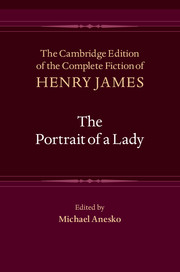Book contents
- Frontmatter
- Contents
- List of Illustrations
- Acknowledgments
- List of Abbreviations
- General Editors’ Preface
- General Chronology of James’s Life and Writings
- Introduction
- Textual Introduction
- Chronology of Composition and Production
- Bibliography
- The Portrait of a Lady
- Glossary of Foreign Words and Phrases
- Notes
- Textual Variants
- Emendations
- Appendices
Chapter 50
Published online by Cambridge University Press: 11 April 2021
- Frontmatter
- Contents
- List of Illustrations
- Acknowledgments
- List of Abbreviations
- General Editors’ Preface
- General Chronology of James’s Life and Writings
- Introduction
- Textual Introduction
- Chronology of Composition and Production
- Bibliography
- The Portrait of a Lady
- Glossary of Foreign Words and Phrases
- Notes
- Textual Variants
- Emendations
- Appendices
Summary
AS the Countess Gemini was not acquainted with the ancient monuments, Isabel occasionally offered to introduce her to these interesting relics and to give their afternoon drive an antiquarian aim. The Countess, who professed to think her sister-in-law a prodigy of learning, never made an objection, and gazed at masses of Roman brickwork as patiently as if they had been mounds of modern drapery. She was not an antiquarian; but she was so delighted to be in Rome that she only desired to float with the current. She would gladly have passed an hour every day in the damp darkness of the Baths of Titus, if it had been a condition of her remaining at the Palazzo Roccanera. Isabel, however, was not a severe cicerone; she used to visit the ruins chiefly because they offered an excuse for talking about other matters than the love-affairs of the ladies of Florence, as to which her companion was never weary of offering information. It must be added that during these visits the Countess was not very active; her preference was to sit in the carriage and exclaim that everything was most interesting. It was in this manner that she had hitherto examined the Coliseum, to the infinite regret of her niece, who—with all the respect that she owed her—could not see why she should not descend from the vehicle and enter the building. Pansy had so little chance to ramble that her view of the case was not wholly disinterested; it may be divined that she had a secret hope that, once inside, her aunt might be induced to climb to the upper tiers. There came a day when the Countess announced her willingness to undertake this feat—a mild afternoon in March, when the windy month expressed itself in occasional puffs of spring. The three ladies went into the Coliseum together, but Isabel left her companions to wander over the place. She had often ascended to those desolate ledges from which the Roman crowd used to bellow applause, and where now the wild flowers (when they are allowed), bloom in the deep crevices; and to-day she felt weary, and preferred to sit in the despoiled arena.
- Type
- Chapter
- Information
- The Portrait of a Lady , pp. 506 - 513Publisher: Cambridge University PressPrint publication year: 2016

